|
Many services provided by Hennepin County Environment and Energy have been modified, canceled, or temporarily suspended due to concerns about the spread of COVID-19. Below is a summary of our current service changes and cancellations. We apologize for any inconvenience this may cause.
Hennepin County is committed to providing services during this time of ambiguity and quickly evolving needs. We’ve mobilized our workforce and are developing new approaches so we can continue to serve residents equitably, efficiently and safely.
We are continuing to monitor the situation and will make additional modifications to our services as needed. Announcements will be included in future editions of Green Notes, on program web pages, and on our social media channels.
Learn about all county service changes and the county’s response to COVID-19 at hennepin.us/covid-19.
Waste management and recycling services that are temporarily closed or canceled
-
Drop-off facilities: The Hennepin County drop-off facilities in Brooklyn Park and Bloomington are temporarily closed to the public until further notice.
-
Hazardous waste collection events: The household hazardous waste collection event scheduled for May 8 and 9 in Minnetonka has been canceled. See the schedule of collection events that are currently scheduled.
-
Medicine drop boxes: Some of the medicine drop boxes that Hennepin County operates with partners are currently closed, while several drop boxes remain open. See a complete list of medicine drop boxes and be sure to follow safe storage guidelines for your medicines.
-
Fix-It Clinics: The Fix-It Clinics scheduled for April 11 at Longfellow Recreation Center in Minneapolis and May 11 at the St. Louis Park Recreation Center have been canceled. You may be able to find repair assistance online through resources like ifixit.com.
For the best way to recycle, reuse or dispose of items, visit the Green Disposal Guide, email environment@hennepin.us or call 612-348-3777.
Storing products properly

Use the following guidelines to safely store household hazardous waste until we are able to accept items again:
- Store out of the reach of children.
- Store in a dry place. Don’t let products freeze.
- Store away from heat or food sources.
- Store in original container and make sure the original label is intact.
- Do not mix products together.
- Batteries should be placed separately in a clear plastic bag OR place clear tape on both the positive (+) and negative (-) terminals of batteries to prevent fires.
Orders for recycling and environmental education resources temporarily suspended
We are unable to fulfill orders of recycling and environmental education resources until further notice. Stay tuned to future editions of Green Notes or visit the web page and sign up for the newsletter for the specific programs you are interested in to stay informed about when these resources will be available again.
Programs affected:
Technical assistance and other services available
Although Hennepin County Environment and Energy staff are working remotely and limiting site visits, we are still available to provide technical assistance on a variety of environmental topics, including:
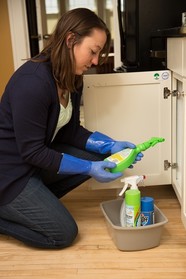
Many people are taking steps to be extra diligent about cleaning and disinfecting around their home. Here are some important guidelines to follow to keep you and your family safe while cleaning.
Cleaning, sanitizing and disinfecting guidelines
The U.S. Centers for Disease Control and Prevention (CDC) has developed recommendations for cleaning and disinfecting of households.
It’s important to understand the difference between cleaning, sanitizing, and disinfecting. The CDC and U.S. Environmental Protection Agency (EPA) explain:
|
- Cleaning removes germs, dirt, and impurities from surfaces or objects
- Sanitizing lowers the number of germs on surfaces or objects
- Disinfecting kills germs on surfaces or objects
The CDC recommends routine cleaning of frequently touched surfaces, such as tables, doorknobs, light switches, handles, desks, toilets, faucets, and sinks with household cleaners and EPA-registered disinfectants that are appropriate for the surface. As with any cleaning product, you should follow label instructions for safe and effective use of the product. Learn more about reading and understanding product labels in our how to identify and reduce hazardous chemicals in your home brochure (PDF).
The CDC explains that cleaning can be accomplished with detergent or soap and water. Sanitizers will state their intended use on the product label, or you can use a simple solution of white vinegar. Find recipes and instructions for homemade cleaners and sanitizers using simple ingredients in our Green Cleaning Recipes brochure (PDF).
For disinfection, the CDC says effective options are: a diluted household bleach solution, alcohol solution with at least 70% alcohol, or most EPA-registered household disinfectants. See the EPA’s list of disinfectant products that meet the EPA’s criteria for use against the novel coronavirus that caused COVID-19.
Products to never mix together
The following products can create toxic vapors and substances when mixed together that are dangerous to your health or even deadly. It’s important to never mix these chemicals together:
-
Bleach and vinegar or other acids like lemon juice and acid-based toilet bowl cleaners: These create toxic chlorine gas that can cause coughing, irritate your eyes, nose, and throat, give you a chemical burn, and be deadly at high enough concentrations.
-
Bleach and ammonia: These create toxic chloramine vapor that quickly causes eye, nose, and throat irritation and can be deadly at high enough concentrations.
-
Bleach and rubbing alcohol: These create toxic chloroform that can cause you to pass out and can be deadly.
-
Vinegar and peroxide: These create peracetic acid that is corrosive, can irritate your eyes, and may give you a chemical burn.
Safe disposal and storage
Disposable cleaning wipes and paper towels with cleaning chemicals should be thrown in the trash.
To prevent sewer problems, cleaning wipes – including wipes labeled “flushable” – should never be flushed down the toilet. Additionally, disposable cleaning wipes and paper towels with cleaning chemicals are not accepted in organics recycling programs.
See the Green Disposal Guide for more information on safe storage and disposal.
Spending more time at home can be a chance to work on adopting low-waste practices. Although striving for zero waste may not be your top priority right now, being productive can help maintain a sense of normalcy and making successful changes can be a source of positivity. Do what you can, but also be kind to yourself.
Here are some ideas:

- Prevent food waste by keeping an inventory of items you have in your pantry, refrigerator, and freezer. Be sure to eat up or preserve the oldest items first.
- Learn a new food preservation technique, such as canning, freezing, or pickling.
|
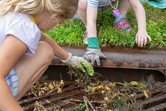
-
Adopt a storm drain. Storm drains flow directly into nearby lakes, rivers, and streams, so now is a perfect time to protect water quality by keeping storm drains clean of sediment, leaves, grass clippings, and litter. Check your drain when you’re on a walk in your neighborhood and be sure to clear them out before any spring rains.
|
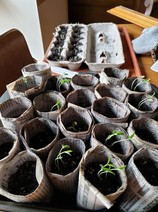
-
Plan a vegetable garden. You can try starting seeds or check with your local garden store to see if they have online ordering options.
- Declutter a space. You may not be able to donate or dispose of things right now, so make sure to plan for how to store things for a while and be sure to label the boxes or bags so you remember what’s in them.
- Study up on low waste topics by reading a book, browsing a blog, or watching a documentary.
|
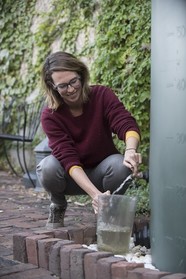
Hennepin County recently awarded eight natural resources grants totaling nearly $315,000. These grants provide financial and technical assistance to landowners and local governments for projects that preserve and restore the county’s natural resources and improve water quality.
The grants will support the implementation stormwater best management practices that slow water movement to naturally filter and retain water. Other projects will capture and reuse rainwater on-site, thereby reducing both runoff and potable water needs. Some projects will undertake stream and shoreline restorations that will improve wetland, woodland, and stream habitat.
Two of these projects are located in areas of concern for environmental justice. Supporting projects that improve water quality, plant trees and create green spaces will improve livability in neighborhoods experiencing disproportionate amounts of economic, environmental, and health disparities.
These projects help the county adapt to a changing climate that is wetter and warmer. Projects that naturally filter and retain water can improve water quality and help reduce localized flooding. Projects that add more trees and native plants help manage stormwater and sequester carbon. These grants leverage the intersection of the natural and built environments to help protect people and places.
Learn about the grants awarded.
|
Salvage, reuse, and recycle building materials from your next remodeling or construction project

To help divert waste from landfills, Hennepin County has grants available to homeowners and developers to deconstruct buildings to salvage building materials rather than demolish them.
Brooklyn Park, Excelsior, and Hopkins have recently been added to the list of eligible cities. Grants are now available for demolition or renovation projects in Brooklyn Center, Brooklyn Park, Edina, Excelsior, Hopkins, Minneapolis, and St. Louis Park that are 250 square feet or larger on structures built prior to 1950.
Deconstruction involves carefully taking a building apart, mostly by hand, and sorting materials into categories for efficient recycling and reuse. Homeowners and developers of residential properties can receive up to $5,000 to help offset the additional time and labor costs associated with deconstruction.
Learn more about the grants including eligibility and requirements at hennepin.us/deconstruction.
For more information, contact Olivia Cashman at olivia.cashman@hennepin.us or 612-348-4843.
|
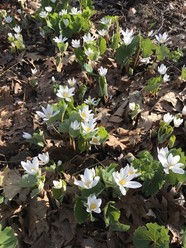
Spring is a time of great change in Minnesota. The snow melts, ice gives way to open water on our lakes, trees and flowers begin to bloom, birds that left for the winter return, and animals emerge from hibernation.
With many of us spending more time at home and in nature, this is a great time to pay attention to phenology, or the study of plant and animal life cycle events that are influenced by environmental changes, especially seasonal variations. The nice thing about phenology is that you can make observations anywhere, including while visiting a park, walking in your neighborhood, sitting in your backyard, or watching from your window.
Each spring can vary depending on temperature and precipitation. For example, the median ice out on Lake Minnetonka is April 13, but this can vary widely from year to year. Ice out on Lake Minnetonka has occurred any time between March 11 and May 5 in the 140 years that data has been collected! So, here’s a general timeline of what to look for in the coming weeks.
|
End of March to early April
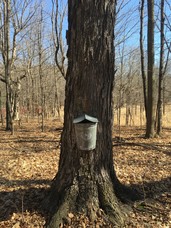
- Frost leaves the ground
- Migrating birds begin to return
- Maple sap starts flowing
- Crocuses start blooming
- Lawns start growing
- The first forest ephemerals like Bloodroot and prairie wildflowers like Pasqueflowers start blooming
- Start to hear the calls of wood frogs and western crocus frogs
- Robins, crows, and Canada geese start building their nests
|
Mid-April
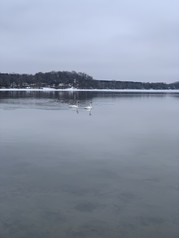
- Ice out occurs on area lakes
- Areas with open water will start to see a variety of waterfowl species migrating through
- More songbirds arrive – be sure to listen to the increasing variety of bird songs
- Gardeners start planting spring vegetables
- Mosquitoes and ticks start to become active – time to revisit your bite prevention measures!
|
Late April to early May
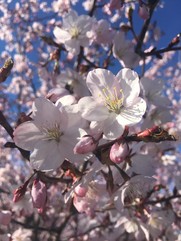
- Ruby-throated hummingbirds, Baltimore orioles, and Rose-breasted grosbeaks return
- Forest ephemerals, including trillium, trout lilies, marsh marigold, and flowering Dutchman’s breeches, increasingly bloom before the trees grow their leaves
- The first of the spring crop – rhubarb – is ready to be harvested
- Common loons return to our lakes
- Apple and crabapple trees start blooming
- Leaves start to sprout on our native basswoods, sugar maples, and red and bur oaks
- Canada geese goslings start to hatch
|
Middle to end of May

- Lilacs bloom
- More forest wildflowers, including lily-of-the-valley, columbine, jack-in-the-pulpit, and wood anemone are in full bloom
- The warbler migration features more than 20 difference species of songbirds
- First butterflies including monarchs and Eastern tiger swallowtails arrive
- White-tail deer fawns are being born
- The calls of frogs in ponds and wetlands become almost constant
- The first harvest comes out of farm fields and gardens
|
Learn more about Minnesota springtime phenology by getting a Weather Guide calendar, checking out the illustrated guide to springtime changes on MinnPost, or reading the climate journal from the Minnesota Department of Natural Resources.
Learn how to contribute to the collection of phenology data through the USA Phenology Network’s Nature’s Notebook or the Minnesota phenology network.
|